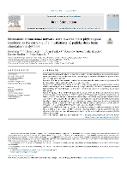Restoration of functional network state towards more physiological condition as the correlate of clinical effects of pallidal deep brain stimulation in dystonia

Autor
Datum vydání
2022Publikováno v
Brain StimulationRočník / Číslo vydání
15 (5)ISBN / ISSN
ISSN: 1935-861XMetadata
Zobrazit celý záznamKolekce
Tato publikace má vydavatelskou verzi s DOI 10.1016/j.brs.2022.08.025
Abstrakt
Background: Deep brain stimulation of the internal globus pallidus (GPi DBS) is an invasive therapeutic modality intended to retune abnormal central nervous system patterns and relieve the patient of dys-tonic or other motor symptoms.Objectives: The aim of the presented research was to determine the neuroanatomical signature of GPi DBS modulation and its association with the clinical outcome.Methods: This open-label fixed-order study with cross-sectional validation against healthy controls analysed the resting-state functional MRI activity changes induced by GPi DBS in 18 dystonia patients of heterogeneous aetiology, focusing on both global (full brain) and local connectivity (local signal homogeneity).Results: Compared to the switched-off state, the activation of GPi DBS led to the restoration of global subcortical connectivity patterns (in both putamina, diencephalon and brainstem) towards those of healthy controls, with positive direct correlation over large-scale cortico-basal ganglia-thalamo-cortical and cerebellar networks with the clinical improvement. Nonetheless, on average, GPi DBS also seemed to bring local connectivity both in the cortical and subcortical regions farther away from the state detected in healthy controls. Interestingly, its correlation with clinical outcome showed that in better DBS re-sponders, local connectivity defied this effect and approached healthy controls.Conclusions: All in all, the extent of restoration of both these main metrics of interest towards the levels found in healthy controls clearly correlated with the clinical improvement, indicating that the restoration of network state towards more physiological condition may be a precondition for successful GPi DBS outcome in dystonia.
Klíčová slova
Deep brain stimulation, Dystonia, Internal globus pallidus, Resting-state functional magnetic, resonance imaging, Connectivity,
Trvalý odkaz
https://hdl.handle.net/20.500.14178/1691Licence
Licence pro užití plného textu výsledku: Creative Commons Uveďte původ 4.0 International






